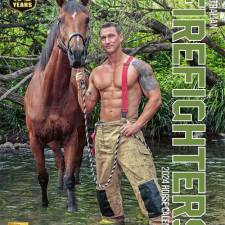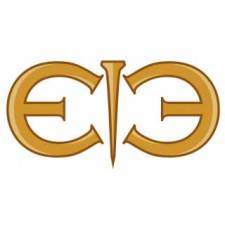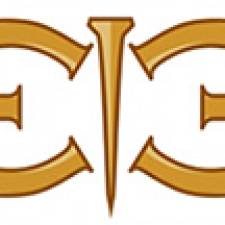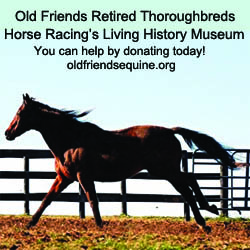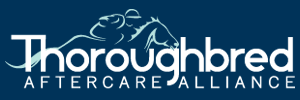
by Natalie Voss
A decade ago, the word “aftercare” was not part of the industry vernacular when talking about Thoroughbreds leaving the racetrack. There were a handful of nonprofits which had battled the tide of horses retiring from racing for years. The Thoroughbred Retirement Foundation launched in 1983, New Vocations Racehorse Adoption Program in 1992, Thoroughbred Charities of America in 1990 – but those organizations' elevator pitches often started with an explanation of why they were necessary to begin with.
The conversation about off-track Thoroughbreds (fondly known as OTTBs) seems to have broadened in 2008 or 2009, in the wake of Eight Belles' high-profile breakdown after the finish of the 2008 Kentucky Derby. If she hadn't suffered a fatal injury, Eight Belles would likely never have found herself in need of retraining or sanctuary at the end of her racing days, but her death on national television prompted industry-wide self-examination. One of the aspects of racing that worried the general public seemed to be the fate of the horses who raced on the Derby undercard – the less accomplished, less successful mares and the many geldings for whom the breeding shed was not a possibility.
So, roughly ten years into the sport's most concentrated efforts to address the problem of aftercare, we at the Paulick Report wanted to know – how are we doing? What is working about the current industry approach to Thoroughbred aftercare, and what isn't? Which populations of Thoroughbreds are being best served by our current aftercare infrastructure, and which are still in need of help?
This three-part series, starting today, will attempt to answer those questions. In Part 1, we tackle the easiest question: What are we, as an industry, doing well in the realm of aftercare?
Michael Blowen is spending a beautiful summer morning doing his favorite thing – checking in on a few of the 175 residents of Old Friends at its Georgetown, Ky., base. As the sun comes up, the light is turning from orange to yellow. Dew is fading from the grass. Retired racehorses are everywhere, grazing peacefully, tossing long manes and watching the first cars pull into the driveway for the morning's tours. While Blowen drives a golf cart up and down the pasture lanes, Soi Phet, Hogy, Sun King, Silver Charm, War Emblem come sidling up, looking for carrots.
“Isn't this the most beautiful thing you ever saw?” he asked, looking out over pastures dotted with graded stakes winners. “Can you imagine being any place but here on a morning like this?”
Blowen jokes that now, 16 years after founding the retirement sanctuary, carrot distribution is his only active role. He's being modest, of course. Blowen has been the public face of Old Friends since it started as a crazy idea he had to create a living history museum of pensioned stallions. He quickly discovered that not many places are equipped to take stallions, who require specific types of facilities, can't be turned out with others, and need experienced handlers. Old Friends launched with one horse in a leased paddock and now includes 136 acres. Its mission has expanded beyond stallions to pensioned horses of all types, including a few retired broodmares or geldings who retired with injuries precluding a second career.
None of it would have been possible, Blowen said, if not for an expanded, industry-wide discussion about aftercare.

Over the past ten years, a variety of nonprofits and for-profit businesses have popped up to address the aftercare problem. Some, like Old Friends, are sanctuaries, focusing mostly on retired horses with no possibility of a second career. Others take in horses for retraining and adopt them out. Still other groups or individuals act as educators and connectors between horses on the track and off-track homes, but don't maintain a facility to take possession of horses themselves.
Even within the rehoming organizations, there are subtypes. Some groups deal in volume, putting small adoption fees on horses to get them out the door to vetted adopters quickly. Others, including for-profit individuals, deal in smaller volume at higher prices, selecting only horses with solid physicals who can command larger adoption fees or sale prices to offset costs.
It wasn't that long ago that none of this existed, according to New Vocations Thoroughbred Program Director Anna Ford.
“If we go back to when we started in 1992, if you said the word 'aftercare' people wouldn't even know what you were talking about,” said Ford. “The awareness of aftercare and the idea that you need to have a plan for your horses after they retire has dramatically improved. That's huge.
“When we started, we were pretty much the only people putting classified ads in the back of the Thoroughbred Times asking people to give us a call if they need help retiring their racehorses. Two of our founding supporters, that's how they found us.”
Even in 2008, the landscape was very different.
“I remember, in the early 2000s I would submit success stories to publications and they weren't interested in them,” said Ford. “It wasn't a thing yet. Now, when I have a success story, everybody wants to talk about it. Now, when I'm talking to people in the industry and you say the word 'aftercare' they can actually have a conversation about it.”
How did we get here?
The journey from aftercare as an abstract concept to becoming omnipresent was, in the grand scheme of paradigm shifts, a quick one.
Susanna Thomas, executive director for the Maker's Mark Secretariat Center, has been working in aftercare since before the shift. One autumn afternoon, Thomas finds herself sitting at a table outside the Keeneland September Yearling Sale, watching sleek young Thoroughbreds go by. Breeders, sales consignors, product representatives come over to shake her hand and arrange meetings at the Center. Every few minutes, with alarming regularity, her phone rings or dings, positively buzzing off the table with the volume of questions she must answer and needs she must consider. She's used to this level of busy. This has been her life, nearly every waking hour, since before “aftercare” was entered into racing's vocabulary.
“It's been a fabulous journey,” said Thomas. “When I started at the Center, I was just helping out. It was October 2007 and slaughter had just become illegal in this country. While there was somewhat of an awareness of the issue, which had been brought to light by the TRF, by CANTER, by NV, Mid-Atlantic Horse Rescue — it really wasn't on anybody's radar.”
Then, Thomas said, several key things happened in quick succession. Social media expanded rapidly. People began using it not just to share vacation photos but to impact social and political change. It became easier than ever to share photos of horses at auctions along the Canadian and Mexican borders, details about horses in neglect situations, and information about OTTBs looking for new homes. Suddenly, the market for OTTBs wasn't just made up of people near an adoption facility's base – it was national. So too, was the scale of OTTBs in need of help.
In 2008, the Great Recession hit nearly everyone in the wallet. People weren't donating, and they weren't adopting. If anything, more of them were looking to surrender their horses than ever before. The equestrian world was somewhat delayed in its recovery from the downturn – horses are luxury items, after all – and even as national economic indicators and unemployment numbers steadied, adoptions stalled. Thomas remembers the squeeze in her early days piloting the Secretariat Center, which at the time was a Thoroughbred Retirement Foundation (TRF) facility.
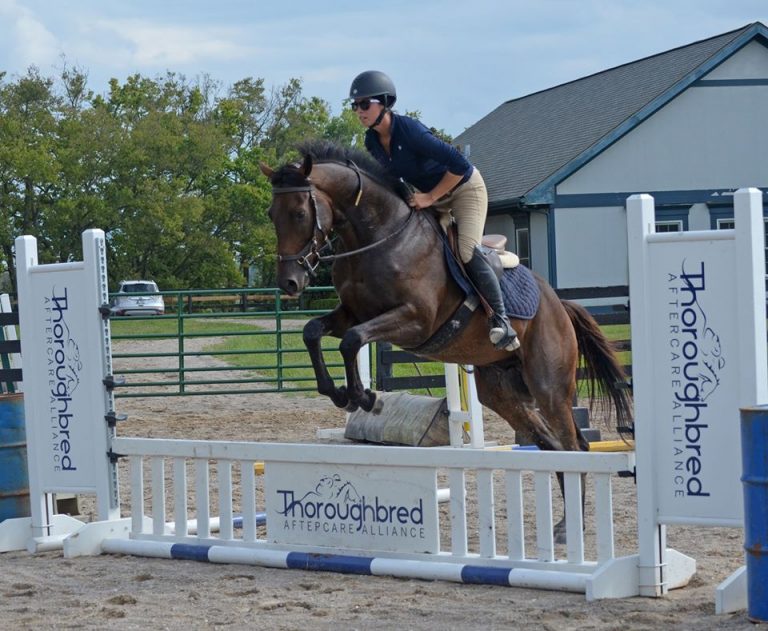
“It really impacted everybody, especially the TRF because they were mostly a sanctuary,” said Thomas. “When people are not writing checks anymore, and you're still feeding and taking care of 2,000 horses … it put untenable strain on them.”
The TRF wasn't the only organization experiencing this crunch, of course. The panic was everywhere. No organization was immune. For Thomas, these factors crystallized into her new operations plan for the Secretariat Center. She decided to use the limitations of a small, 16-acre property, combined with the high visibility of its Kentucky Horse Park location, to showcase the type of OTTB that would move quickly and make the racing industry look good – a sound, sane horse (usually a gelding) with basic training and an adoption fee to match.
“At the time, very few people were reschooling. Now, everybody's doing it,” she said.
At the same time, the racing industry was becoming more aware of its responsibilities (and public relations challenges) behind a previously-tepid attitude toward aftercare. Beginning in 2009, The Jockey Club and Thoroughbred Charities of America offered an optional check-off program to breeders registering new foals. The program gave the breeder the chance to donate a designated amount to aftercare via the Thoroughbred Charities of America, and The Jockey Club would match that amount.
As aftercare became higher profile, established organizations gained steam, all of them competing for fundraising dollars. Other, less-organized, less well-managed programs began popping up, too. Enter the Thoroughbred Aftercare Alliance, launched in 2012 as an accreditation and fundraising body for aftercare organizations. Since its foundation, the TAA has given away $17.2 million to accredited groups which have served 10,300 Thoroughbreds. As of this year, there are 74 organizations with some 160 facilities that are TAA accredited.
“The best thing that's happened to aftercare since I started is the TAA,” said Michael Blowen. “You're always afraid there's going to be somebody that's going to break the rules and horses will end up in a bad situation. Their accreditation process is so difficult and time consuming. We went through an IRS audit, and that was nothing compared to what the TAA does. Now, I know if somebody sends a horse to a TAA-accredited facility, I know it's going to be ok.”
The TAA also addressed the acute need for the industry to have a group to point to, showing its commitment to aftercare. The organization maintains a lengthy list of farms, sale companies, horsemen's groups, wagering companies, and others who have written checks or developed fundraising programs for the group. The major Thoroughbred auction houses now offer buyers and consignors the chance to donate a portion of a horse's sale price to the TAA. Farms can commit up to 25 percent of a stallion's advertised stud fee. More recently, special technology has been added to some automatic wagering machines to allow horseplayers to donate a portion of their winnings to the TAA.
And commitment to the TAA is growing – earlier this summer, the New York Racing Association and New York Thoroughbred Horsemen's Association announced 1.5 percent of a claimed horse's tag price would go toward the TAA and Take The Lead, NYTHA's aftercare organization. The groups also said they would increase the per-start fee for all New York runners from $5 to $10. The two changes are expected to bring in $1 million more to aftercare each year.
While the TAA was getting up and running, several horsemen realized the best way to ensure a horse has a home is to make sure he has value. There had been a time, some 50 years ago, when OTTBs were wildly popular in equestrian sports for their versatility, tenacity, and athleticism. If there were a way to incentivize people to think about an OTTB for their next riding horse, the Thoroughbred could stop being a charity case and start being a commodity.
Steuart Pittman started the Retired Racehorse Training Project (RRP) in 2010 as an educational and advocacy group for those interested in retraining OTTBs. By 2013, that had expanded into the Thoroughbred Makeover, a challenge program with a time limit for professionals to work with recent runners before showing off their handiwork in a public exhibition. Now, the Makeover is open to professionals and amateurs.
“Our mission, overarching, is to increase the value and demand for horses in the sport horse world and one part of that is if they need to retire from racing, have an avenue for them to do so easily, safely and quickly to have more people wanting them,” said Jen Roytz, executive director of the Retired Racehorse Project.
The requirements for the Thoroughbred Makeover tend to favor horses who were lightly raced and retired sound, but it's not limited to that type of OTTB. About two-thirds of this year's Makeover horses earned $50,000 or less at the track, and a third of them ran ten or fewer times. Over half are 4- and 5-year-olds. The Makeover had 55 “war horses” entered, designated as those with 50 or more starts. One-time Kentucky Derby hopeful Samraat was among the competitors, with earnings over $1 million.
Roytz said the competition requires horses to have recent race results or published workouts, but also has a built-in waiting period that can allow horses retiring with injuries plenty of time to lay off before they begin retraining. While the Makeover model often favors horses that can go into retraining with minimal delay, it's designed to work with all types of OTTBs and to show their value to the general public.
A number of high point awards are also on offer for horses adopted from specific groups, or for state-breds via groups like the Louisiana Thoroughbred Breeders Association and Pennsylvania Horse Breeders Association.
Makeover graduates are often offered for sale, sometimes for as much as $12,000 or $15,000 at the end of the program, by which time they have benefitted from months of training and often have accumulated an impressive show resume.
“We're trying to market Thoroughbreds to equestrians so they hopefully choose a Thoroughbred over another breed of horse for their next show horse, lesson horse, trail horse, recreation horse,” said Roytz. “I think the needle's moving. I'm very proud to say that we're a part of that but I think we're only a part of that. There are so many people doing so much good work out there.”
There are also a number of incentives for people competing OTTBs beyond Thoroughbred Makeover. The Jockey Club's Thoroughbred Incentive Program is the biggest, with more than 1,300 events across the country offering bonus prizes for TIP participants, including a year-end championship. TIP has also initiated non-performance awards for trail horses or those in non-mounted vocations like therapy.
Similarly, TAKE2 has offered extra prize money to hunters and jumpers in Thoroughbred-only classes. In 2010, the Thoroughbred Owners and Breeders Association created the Thoroughbred Sport Horse of the Year award, designed to recognize OTTBs excelling in new careers.
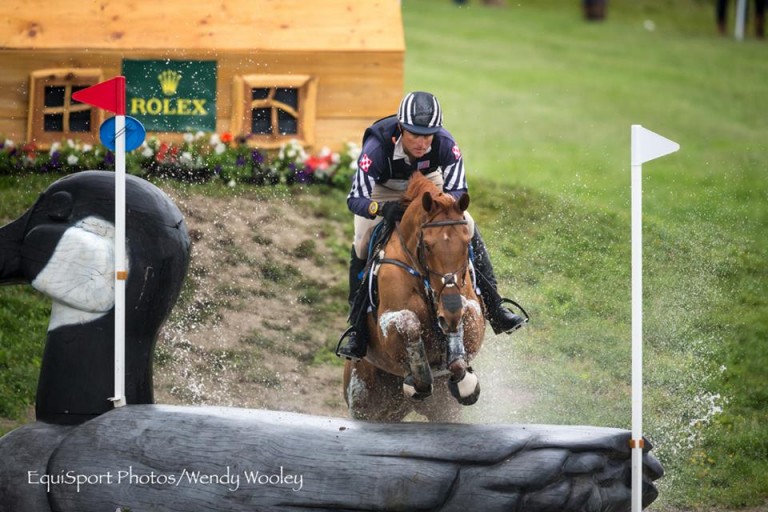
OTTBs are also gaining more visibility in the show ring, with several publications tracking Thoroughbreds participating in the Land Rover Kentucky Event each year, and others grabbing headlines at the Hampton Classic and similar high-profile spots.
All this interest has made it easier to find homes for athletic, well-minded, sound horses. So much so, a number of professional sport horse trainers have begun dealing almost exclusively in OTTBs in their for-profit businesses.
Stephanie Calendrillo has been retraining and selling horses for most of her professional life, and has participated in the past two editions of the Thoroughbred Makeover. From her Central Kentucky base, she has seen prices for the right type of retiring racehorse rise this time of year, when Makeover participants are out seeking horses for next year. (The Makeover requires horses to have raced or had a published work within a certain timeframe of the Makeover's start, and does not allow trainers to begin full-time retraining until Dec. 1.)
“I think the market is a lot better for Thoroughbreds now because of all the publicity around aftercare,” said Calendrillo. “And it's because of RRP. Everyone wants to do it now, so more horses are getting placed in good homes.
“The prices of horses, because of RRP, has tripled. There are [racetrack] trainers now who are trying to sell their horses for close to $5,000, where before all this it was $2,000. That was your average. Now there are people with nice horses who can charge more [straight off the track]. Prices have gone up considerably because of all of this. Same horse either way. And some people, like the hunter/jumpers, are willing to pay that.”
That can make it difficult for professionals like Calendrillo to gain the same profit on OTTBs they used to, and some have had to raise their own prices to keep up. But while that may be unwelcome news to sport horse professionals, it means the right type of horse has many more options for life after the track than it did ten years ago. Before OTTBs became popular, they weren't selling as well straight off the track, and it wasn't so easy to sell them with 90 days' training, either. Now, the right type of horse has value at both points in his career and even more value a year into a new career.
A snapshot of the Kentucky Horse Park in October is the realization of a vision come to life for many in the aftercare realm. On every horse path, in every ring, are OTTBs of all ages and body types. Horses approach the ring followed by a trail of coaches, friends, and families of the riders. When they step on course to compete, announcers tout their racing history and pedigrees. Many of them will accept mints and pats from their breeders, racing owners, or former track grooms back at the barn. Everyone seems to be wearing t-shirts and hats exalting the Thoroughbred.
“A few times a day it hits me,” said Roytz. “I walk around so impressed by how good these horses look and how well they're doing. And then it hits me — they're all in their first year of retraining after racing. If these horses can accomplish all that in the first year, then how bright is their future?”
This article was originally published on Paulick Report and is published here with permission.
Find more relevant articles in our section on Retire & Rehome.








